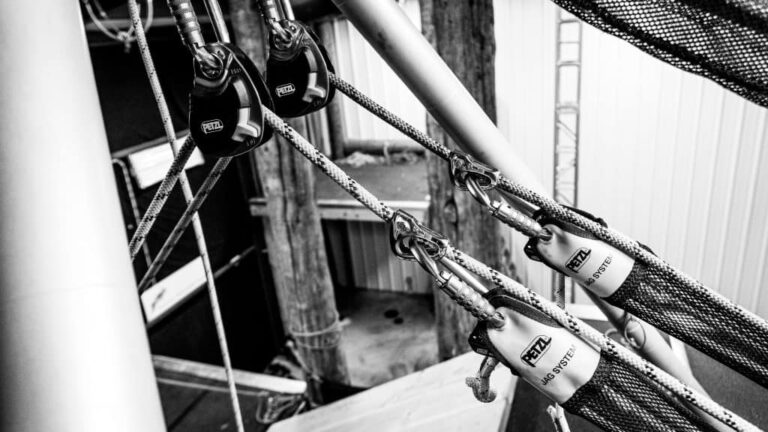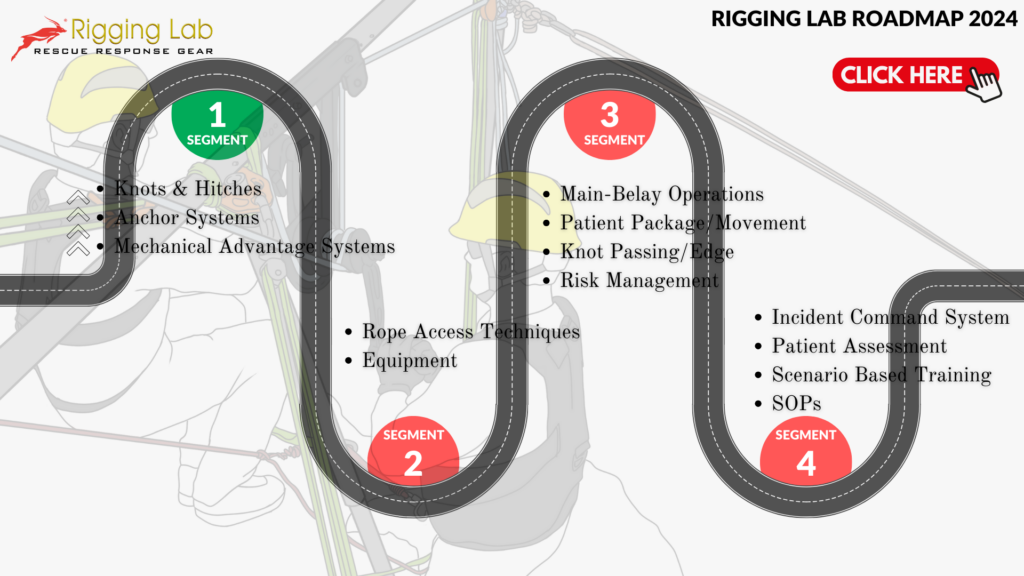Confined space rescue at the technician level involves advanced skills and specialized equipment to manage the most challenging scenarios. This blog covers critical aspects of mastering confined space rescue technician operations, focusing on the use of supplied air respirators, short spinal packaging devices, and complex rigging systems.
The Use of Supplied Air Respirators
Supplied air respirators (SARs) are essential for environments where the air quality is compromised, such as areas with toxic gases or insufficient oxygen levels. SARs provide a continuous supply of breathable air from an external source, ensuring the safety of the rescuers.
- Training and Usage: All team members must be thoroughly trained in the proper use and maintenance of SARs. Regular drills and practical sessions help build proficiency and confidence in using this equipment (Rigging Lab Academy) (Rigging Lab Academy).
- Equipment Checks: Regularly inspect and maintain SARs to ensure they are in optimal working condition. This includes checking the air supply, hoses, and connections for any signs of wear or damage.
The Use of Short Spinal Packaging Devices
Short spinal packaging devices, such as the Yates Spec Pak, are designed for confined space rescues where full-length stretchers are impractical. These devices provide the necessary spinal support while allowing for easier maneuverability through tight spaces.
- Spec Pak Training: Mastering the use of the Yates Spec Pak involves understanding how to secure the patient effectively and transport them safely through confined spaces. Training sessions should include both theoretical and practical components to ensure rescuers are adept at using the Spec Pak in various scenarios (Rigging Lab Academy) (Rigging Lab Academy).
- Patient Handling: Emphasize gentle handling and stabilization techniques to prevent further injury during extraction. The Spec Pak’s design allows for vertical and horizontal transport, making it versatile for different rescue situations.
The Use of More Complex Rigging Systems
Complex rigging systems are essential for navigating the challenging environments encountered in confined space rescues. These systems include reeving systems, skate blocks, and various mechanical advantage setups.
- Reeving Systems: The English Reeve and Norwegian Reeve systems are advanced rigging setups that provide flexibility and control in confined space rescues. These systems allow for precise movement of the load, making it easier to navigate obstacles and tight passages (Rigging Lab Academy) (Rigging Lab Academy).
- Skate Blocks: Skate blocks facilitate smooth movement of the load over edges and through confined spaces. Training in the setup and use of skate blocks is essential for ensuring smooth and safe operations (Rigging Lab Academy) (Rigging Lab Academy).
- Mechanical Advantage Systems: Systems like the split 4:1 and 2:1 mechanical advantage setups reduce the physical effort required to lift and lower loads. These systems are crucial for safely managing heavy loads in confined spaces (Rigging Lab Academy).
Unit 2: Packaging Patient in the Yates Spec Pak
Introduction to the Spec Pak: The Yates Spec Pak is a versatile short spinal packaging device designed for confined space rescues. Its compact design allows for easy maneuvering through tight spaces while providing the necessary spinal support to prevent further injury during extraction (Rigging Lab Academy) (Rigging Lab Academy).
Patient Packaging with the Spec Pak: Properly securing the patient in the Spec Pak is critical. This involves:
- Step-by-Step Securing: Follow specific steps to ensure the patient is securely strapped in. Use additional supports if necessary to stabilize the head and neck.
- Horizontal and Vertical Transport: The Spec Pak allows for both horizontal and vertical transport, making it suitable for various confined space scenarios (Rigging Lab Academy).
Spec Pak Packaging in a Hole:
- Practical Demonstrations: Utilize video tutorials and hands-on practice to master the techniques of packaging a patient in a confined space, ensuring safety and stability throughout the process (Rigging Lab Academy).
Unit 3: Supplied Air & Communications
SAR Usage and Maintenance:
- Comprehensive Training: All team members must be proficient in donning, doffing, and operating SARs. Training should cover emergency procedures, recognizing signs of equipment malfunction, and conducting regular maintenance checks (Rigging Lab Academy).
- Regular Drills: Conduct frequent drills to ensure all team members can efficiently use SARs in various scenarios (Rigging Lab Academy).
Effective Communication Strategies:
- Communication Devices: Use reliable communication devices designed for confined space operations. These should be tested regularly to ensure they function correctly in emergency situations (Rigging Lab Academy).
- Protocols: Establish clear communication protocols, including regular check-ins and emergency signals, to maintain constant communication between team members (Rigging Lab Academy).
Unit 4: Confined Space Rescue Entry
Full Scenario Top-Side Entry Rescues:
- Scenario-Based Training: Engage in full scenario-based training to simulate real-life rescue situations. This includes practicing entry, navigation, and extraction techniques under various conditions (Rigging Lab Academy) (Rigging Lab Academy).
Application of A.T.L.A.S.T. Principles:
- Atmosphere, Time, Locate, Access, Stabilize, Transport: Apply the A.T.L.A.S.T. framework to ensure all critical aspects of the rescue are addressed. Training should emphasize each component and how it integrates into the overall rescue strategy (Rigging Lab Academy).
Practical Sessions on Maneuvering Through Confined Spaces:
- Hands-On Practice: Conduct hands-on practice sessions to build proficiency in maneuvering through confined spaces, including navigating obstacles and safely extracting the patient (Rigging Lab Academy).
Unit 5: Complex Rigging Systems: Reeving Systems
Overview and Practical Setup:
- English Reeve and Norwegian Reeve Systems: Learn the setup and use of these advanced rigging systems. Training should cover the components, assembly, and operation of these systems in various confined space scenarios (Rigging Lab Academy) (Rigging Lab Academy).
Video Tutorials:
- Control and Middle Sections: Utilize video tutorials to understand the detailed setup and operation of the control and middle sections of the reeving systems. Visual aids can enhance understanding and retention of complex rigging techniques (Rigging Lab Academy).
Unit 6: Complex Rigging Systems: Skate Blocks
Setup and Usage of Skate Blocks:
- Practical Demonstrations: Engage in practical demonstrations to master the setup and use of skate blocks. These sessions should cover how to move loads smoothly over edges and through confined spaces (Rigging Lab Academy) (Rigging Lab Academy).
Video Tutorials:
- Detailed Instructions: Use video tutorials to gain a step-by-step understanding of setting up and operating skate blocks. These resources provide visual guidance on best practices and troubleshooting (Rigging Lab Academy).
Unit 7: Other Rigging Systems
Bash Kit Components and Quick Response Packs:
- Essential Tools: Learn about the components of bash kits and quick response packs, which are essential for rapid deployment in confined space rescues. Training should cover the use and maintenance of these tools (Rigging Lab Academy).
Split 4:1 and Tripod Reeve Systems:
- Advanced Techniques: Master the advanced rigging techniques of the split 4:1 and tripod reeve systems. These setups provide the necessary mechanical advantage for lifting and lowering loads in confined spaces (Rigging Lab Academy).
Video Tutorials:
- Comprehensive Training: Utilize video tutorials to cover the setup, operation, and troubleshooting of various rigging systems, including the inchworm technique and body weight anchors. These resources provide visual and practical guidance to enhance learning (Rigging Lab Academy).
Conclusion
Mastering confined space rescue at the technician level requires a deep understanding of advanced equipment and techniques. By focusing on the use of supplied air respirators, short spinal packaging devices, and complex rigging systems, rescue teams can enhance their effectiveness and safety during operations. Continuous training and practical sessions are essential to maintain high standards and readiness for any emergency.
For detailed training and courses, visit Rigging Lab Academy and explore their extensive resources on mechanical advantage systems and other advanced rescue techniques.










